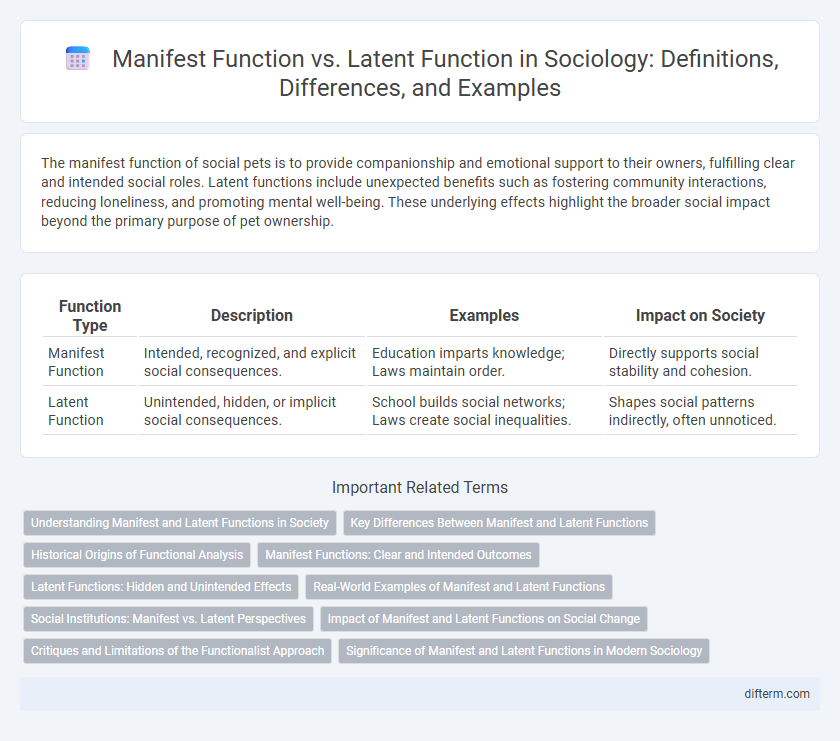The manifest function of social pets is to provide companionship and emotional support to their owners, fulfilling clear and intended social roles. Latent functions include unexpected benefits such as fostering community interactions, reducing loneliness, and promoting mental well-being. These underlying effects highlight the broader social impact beyond the primary purpose of pet ownership.
Table of Comparison
| Function Type | Description | Examples | Impact on Society |
|---|---|---|---|
| Manifest Function | Intended, recognized, and explicit social consequences. | Education imparts knowledge; Laws maintain order. | Directly supports social stability and cohesion. |
| Latent Function | Unintended, hidden, or implicit social consequences. | School builds social networks; Laws create social inequalities. | Shapes social patterns indirectly, often unnoticed. |
Understanding Manifest and Latent Functions in Society
Manifest functions are the intended and recognized consequences of social institutions or actions, such as education providing knowledge and skills. Latent functions refer to the unintended or hidden outcomes, like schools fostering social networks and creating peer groups. Understanding both functions reveals the complex roles institutions play in maintaining social order and contributing to societal change.
Key Differences Between Manifest and Latent Functions
Manifest functions are the intended and recognized consequences of social actions or institutions, such as education providing knowledge and skills. Latent functions represent the unintended or unrecognized outcomes, like schools promoting social networks and peer relationships. The key difference lies in manifest functions being deliberate and obvious, whereas latent functions are hidden and often overlooked but equally influential on social structures.
Historical Origins of Functional Analysis
Functional analysis in sociology originated with Emile Durkheim, who emphasized manifest functions as the recognized and intended consequences of social institutions, while latent functions represent the unintended and often hidden outcomes. Talcott Parsons further developed this framework by integrating both manifest and latent functions into a comprehensive system of social stability and cohesion. This theoretical foundation laid the groundwork for understanding how social structures maintain equilibrium and address both overt and covert societal needs.
Manifest Functions: Clear and Intended Outcomes
Manifest functions refer to the deliberate and recognized consequences of social actions or institutions, such as education providing knowledge and skills for employment. These outcomes are explicitly intended and openly acknowledged by participants within a society. The clarity of manifest functions helps maintain social order by aligning individual behaviors with collective goals.
Latent Functions: Hidden and Unintended Effects
Latent functions in social systems refer to hidden, unintended effects that are not immediately recognized by participants but significantly influence social stability and change. These functions often maintain social order by reinforcing norms, promoting social cohesion, or creating new opportunities, despite not being the explicit purpose of an institution or activity. Understanding latent functions sheds light on the complex, underlying dynamics that shape human behavior and social structures beyond their manifest purposes.
Real-World Examples of Manifest and Latent Functions
Manifest functions of education include teaching essential skills and promoting literacy, which directly benefit students and society by preparing a competent workforce. Latent functions of education involve social networking and fostering cultural norms, often leading to unintentional benefits like forming lifelong friendships and reinforcing social values. For example, while a school's manifest function is academic achievement, its latent function may include creating social hierarchies or encouraging extracurricular interests.
Social Institutions: Manifest vs. Latent Perspectives
Social institutions serve manifest functions such as maintaining order, providing education, and ensuring economic stability, which are intended and recognized outcomes. Latent functions, often overlooked, include reinforcing social norms, fostering social networks, and perpetuating inequalities within these institutions. Understanding both manifest and latent functions provides a comprehensive view of how social institutions shape individual behavior and societal organization.
Impact of Manifest and Latent Functions on Social Change
Manifest functions, such as laws promoting education, explicitly drive social change by creating intended benefits like increased literacy and economic growth. Latent functions, including unanticipated social networks formed through school attendance, also significantly influence societal shifts by fostering community bonds and cultural integration. Both manifest and latent functions interact dynamically to shape the pace and direction of social transformation.
Critiques and Limitations of the Functionalist Approach
Critiques of the functionalist approach emphasize its tendency to overlook social inequalities and power imbalances by focusing primarily on social stability and cohesion. The distinction between manifest and latent functions often ignores the potential for negative consequences or dysfunctions within social institutions. Moreover, functionalism can be criticized for being overly deterministic, assuming all social phenomena serve a purpose, thereby neglecting individual agency and social change.
Significance of Manifest and Latent Functions in Modern Sociology
Manifest functions in modern sociology represent the intended, explicit outcomes of social actions and institutions, such as education fostering knowledge and skills. Latent functions refer to the hidden, unintended consequences that can reinforce social norms or contribute to social cohesion, like schools promoting social networks. Understanding both functions is crucial for analyzing complex societal dynamics and addressing social issues effectively.
manifest function vs latent function Infographic

 difterm.com
difterm.com